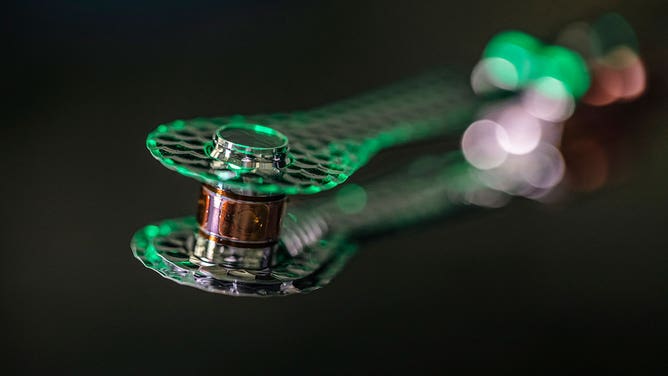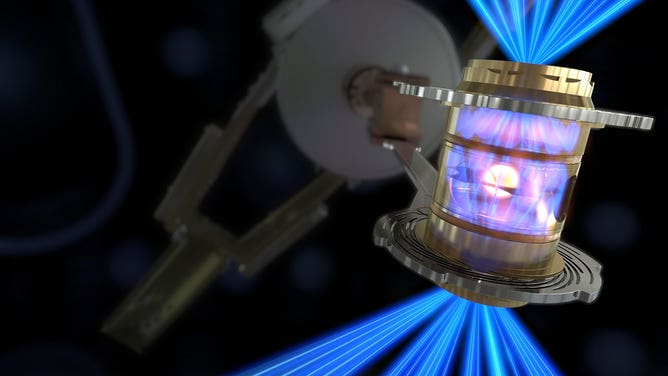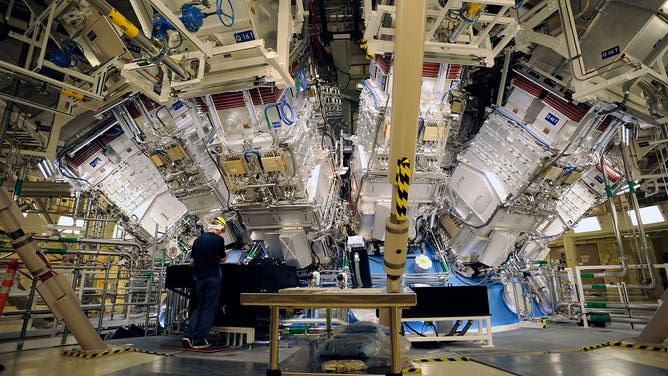Scientists make ‘monumental’ breakthrough in nuclear fusion raising hopes of clean-energy future
After more than 60 years of research and development, scientists said a fusion reaction produced more energy than the laser energy used to create it.

National Nuclear Security Administration Deputy Administrator for Defense Programs Dr. Marvin Adams holds up a cylinder he says is similar to one used by the Lawrence Livermore National Laboratories for a breakthrough in fusion research during a news conference at the Department of Energy headquarters on December 13, 2022 in Washington.
(Chip Somodevilla / Getty Images)
WASHINGTON – More than 60 years of research led up to the breakthrough in nuclear fusion that was announced Tuesday.
Scientists at the Lawrence Livermore National Laboratory in California conducted a controlled fusion experiment Dec. 5 that, for the first time, created more energy than the laser energy required to create it, according to the Department of Energy.

The hohlraum that houses the type of cryogenic target used to achieve ignition on Dec. 5, 2022, at LLNL’s National Ignition Facility.
(DOE / FOX Weather)
"The pursuit of fusion ignition in the laboratory is one of the most significant scientific challenges ever tackled by humanity, and achieving it is a triumph of science, engineering, and most of all, people," LLNL Director Kim Budil said in a news release. "Crossing this threshold is the vision that has driven 60 years of dedicated pursuit — a continual process of learning, building, expanding knowledge and capability, and then finding ways to overcome the new challenges that emerged. These are the problems that the U.S. national laboratories were created to solve."
Fusion happens when two atoms slam together to form a heavier atom. It’s the same process that powers the sun. The reaction produces a tremendous amount of carbon-free energy with no radioactive byproducts.
Fission, which is used to generate energy in nuclear power plants, is the opposite of fusion. The reaction requires atoms to be split to create a large amount of carbon-free energy. Fission leaves behind radioactive waste.
The trouble with fusion is that it takes a tremendous amount of pressure and heat to force the two atoms together. Heat is easy, but the pressure needed to maintain the reaction is much harder to create. Until now, it has taken more energy to produce a successful fusion reaction than what the reaction produced.
According to the Energy Department, scientists used the world’s largest and most energetic laser system at the lab’s stadium-sized National Ignition Facility last week to produce a reaction that surpassed the fusion threshold, meaning it generated more energy than was used to create it. The experiment used 2.05 megajoules of energy to fuse atoms, resulting in 3.15 megajoules of energy output.

To create fusion ignition, the National Ignition Facility’s laser energy is converted into X-rays inside the hohlraum, which then compress a fuel capsule until it implodes, creating a high temperature, high pressure plasma.
(DOE illustration / FOX Weather)
That energy output is the equivalent of the energy created by a standard car traveling at 125 mph, scientists told FOX Weather.
"This monumental scientific breakthrough is a milestone for the future of clean energy," said U.S. Sen. Alex Padilla, of California. "While there is more work ahead to harness the potential of fusion energy, I am proud that California scientists continue to lead the way in developing clean energy technologies.
Officials at the Department of Energy said the agency has restarted efforts to drive rapid progress toward the commercialization of fusion energy.

Engineers work outside the structure where the array of lasers at the National Ignition Facility at Lawrence Livermore Laboratory are focused.
(David Butow/Corbis / Getty Images)